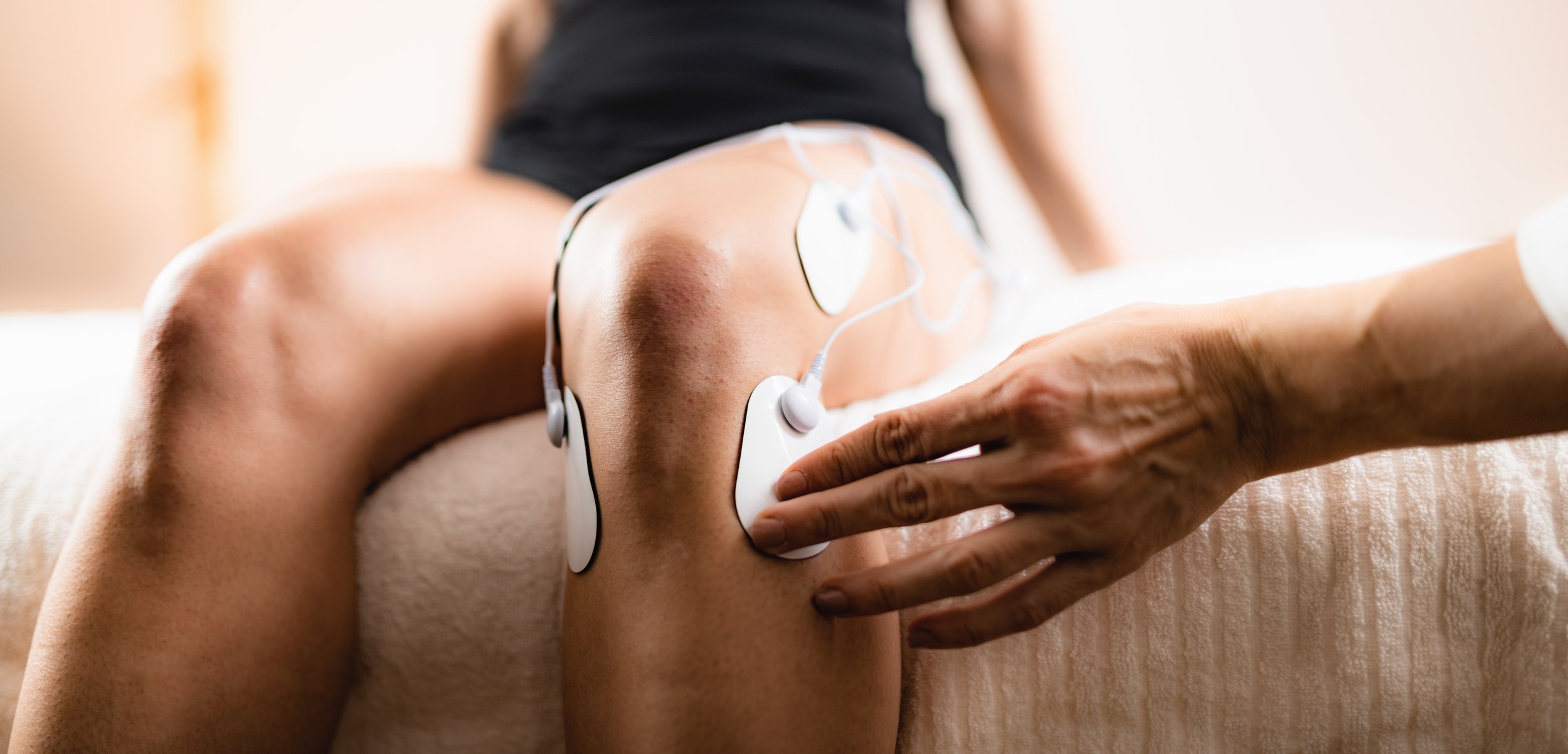
Electrical Stimulation Physical Therapy
AT EVOLVE
Electric Stimulation Physical Therapy
Electrical Stimulation
Electrical stimulation is one of several different types of modalities that physical therapists may utilize during your treatment. The properties of electrical stimulation can be utilized for several different purposes depending on the type and waveform.
WHAT IS ELECTRICAL STIMULATION?
Electrical stimulation refers to the use of a device to send electrical impulses through the skin to the sensory and motor nerves in the skin, fascia and muscles. Electrical stimulation devices range from small hand-held devices for a single person to larger devices that can supply electrical stimulation to more than one person at a time. Stimulation is delivered through electrodes placed on the skin over the area to be treated..
There are several types of electrical stimulation that differ based on the quality of the stimulation and how the device is used. Variations in waveform, amplitude and intensity lead to different effects from the electrical stimulation. Your therapist will decide which type of electrical stimulation to use based on what they have available in the clinic and also on the goal of the treatment. In many cases electrical stimulation is used in the acute phase of healing but in some cases such as with chronic pain or when recovering from a neurologic injury it may be used for longer duration. You may also be aware of electrical stimulation devices recently gaining popularity amongst athletes as a way to enhance both recovery and performance.
WHY IS ELECTRICAL STIMULATION USED?
Electrical stimulation may be utilized for several purposes. Some of the common goals of electrical stimulation are as follows:
- Decrease pain
- Promote healing
- Muscle re-education and strengthening
- Increase range of motion
- Increase circulation
- Reduce edema
- Decrease inflammation
- Decrease spasticity
- Improve overall function
WHAT ARE THE DIFFERENT TYPES OF ELECTRICAL STIMULATION USED BY PHYSICAL THERAPISTS?
As mentioned above, there are several different types of electrical stimulation. Each one is designed for a specific purpose. If your PT decides electrical stimulation is indicated in your care, they will select the type of stimulation based on their goals. Here is a list of some of the most common types of electrical stimulation used in physical therapy:
TENS (Transcutaneous Electrical Nerve Stimulation): Stimulates sensory nerves to decrease pain. May be used to manage soreness or aching muscles and is commonly used in the management of chronic pain.
IFC (Interferential current): This type of electrical stimulation is also indicated for the management of acute, chronic, post-surgical or post-traumatic pain.
Russian stimulation: A more powerful type of electrical stimulation, Russian stimulation is intended to elicit a muscle contraction by stimulating the motor nerves in the muscles below the electrodes. This type of stimulation is used to accelerate muscle recovery and improve muscle strength, endurance and recruitment. This type of stimulation is often used following injuries or surgeries that have caused some muscle atrophy.
NMES (Neuromuscular Electrical Stimulation): Primarily used for muscle re-education, NMES is typically used to stimulate a muscle to contract–though sometimes just targets the sensory nerves in the area–to help re-educate a weakened muscle. It can help to prevent muscle atrophy and improve circulation. It is often used in a neurologic setting for clients who have experienced conditions like a stroke or spinal cord injury. By stimulating a muscle externally, it aims to restore the connection between the brain and the nerve controlling the muscle which can be affected by conditions affecting the brain or spinal cord.
FES (Functional Electrical Stimulation): Functional Electrical Stimulation refers to the use of NMES within a functional activity. One example of FES is an FES bike in which a client will pedal a bike while electrical stimulation triggers the appropriate muscles in the leg to help retrain them. It can also be used with specialized bracing to trigger the hand to open or close during reaching or the foot to lift while walking.
Iontophoresis: This is a more specialized type of electrical current that helps transport medications through the skin. These medications are prescribed by your doctor and applied to specialized electrodes and placed over the affected area. The type of drug utilized will determine the effect of the treatment but iontophoresis may be used to decrease inflammation, decrease pain, manage scar tissue or reduce calcium deposits.
End Injury Progression
Electrical stimulation physical therapy has proven to slow and even stop back pain issues and injury progression in many cases.
Relieve Pain
This treatment used in this technique can target your lower back, upper back, hips, shoulders, and neck helping you to manage pain during the course of your physical therapy treatments.
Improve Range of Motion
Posture awareness is an important area to focus on due to the fact that certain positions may cause you further discomfort and pain.
Restore Mobility
You can gain mobility and flexibility by taking part in the stretches and exercises as prescribed by your physical therapist.
How Long Will Electrical Stimulation Physical Therapy Treatments Last?
If you decide to work with a physical therapist to help correct your PT related issues, your entire treatment plan could consist of around 8-20+ different physical therapy sessions that will each last 60-90 minutes. Once you complete your customized physical therapy treatment plan, you will be able to continue to do the prescribed stretches and exercises utilized during your PT sessions yet in the comfort of your own home.
IS ELECTRICAL STIMULATION FOR EVERYONE?
Electrical stimulation is not necessary or indicated in all cases. Electrical stimulation is just one tool in a therapist’s toolbox and your therapist may recommend other modalities or treatment interventions over electrical stimulation in some cases. One of the goals of physical therapy is to decrease your reliance on the physical therapist over time. Since electrical stimulation is a tool that can often be utilized only in the clinic, your therapist may choose to use this modality only for a short period of time.
Electrical stimulation is contraindicated in the presence of certain medical conditions or devices. Be sure to tell your physical therapist your entire medical history so that they can decide if electrical stimulation is a safe option for you.
Whether your therapist elects to use electrical stimulation or not, my team of therapists and I have a large toolbox of interventions ready to address your concerns. Modalities like electrical stimulation may be beneficial in some cases but you can expect we will take the time to understand all the contributing factors to your condition and make a plan to address as many of them as possible. In this way we hope to improve your symptoms through our care and empower you to manage them longterm on your own
If you are dealing with a disc herniation and are ready to find a long-lasting solution to your pain call us today to learn more about our services and schedule an evaluation
Mill Basin (located in Harbor Fitness)
6161 Strickland Ave
Brooklyn, NY 11234
Monday: 7am-8pm
Tuesday: 7am-8pm
Wednesday: 8am-5pm
Thursday: 7am-8pm
Friday: 8am-1pm
Park Slope (located in Harbor Fitness)
550 5th Ave.
Brooklyn, NY 11215
Monday: 9am-8pm
Tuesday: 8am-6pm
Wednesday: 9am-8pm
Thursday: 8am-6pm
Friday: 8am-3pm
Gravesend
372 Avenue U
Brooklyn, NY 11223
Monday-Thursday: 8am-8pm
Friday: 8am-3pm
Ready to take the next step to a healthier you?
Contact Us Today!
ELECTRICAL STIMULATION PHYSICAL THERAPY AT EVOLVE!
Need Electrical Stimulation Physical Therapy?
Let our caring and compassionate physical therapists help you with relieving pain while getting you back on your feet comfortably.
Call now to schedule your first PT consultation free of charge.
Call: 1-718-395-6551







